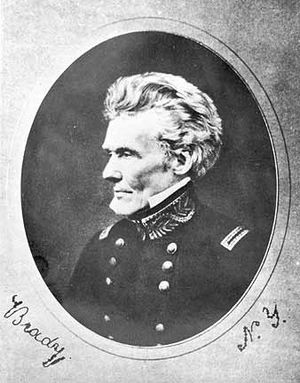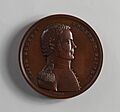Edmund P. Gaines facts for kids
Quick facts for kids
Edmund P. Gaines
|
|
|---|---|

Gaines in uniform, ca. 1845
|
|
| Born | March 20, 1777 Culpeper County, Virginia, U.S. |
| Died | June 6, 1849 (aged 72) New Orleans, Louisiana, U.S. |
| Buried |
Church Street Graveyard,
Mobile, Alabama, U.S. |
| Allegiance | |
| Service/ |
United States Army |
| Years of service | 1799–1800 1801–1849 |
| Rank | |
| Commands held |
|
| Battles/wars | |
| Awards | Congressional Gold Medal |
| Spouse(s) |
|
| Relations | George S. Gaines (brother) Edmund Pendleton (great-uncle) |
Edmund Pendleton Gaines (born March 20, 1777 – died June 6, 1849) was an important officer in the United States Army. He served for almost 50 years. He reached the rank of major general through a special honor called a brevet promotion. Gaines was one of the top commanders in the Army during its early years in the 1800s. He fought in several major conflicts, including the War of 1812, the Seminole Wars, the Black Hawk War, and the Mexican–American War.
Gaines was born in Culpeper County, Virginia. He was named after his great-uncle, Edmund Pendleton, a famous political leader. Gaines joined the Army in 1799 as an ensign. He left for a year but returned in 1801 and stayed in the Army until he died. Early in his career, he helped build important roads, like a federal post road from Nashville, Tennessee to Natchez, Mississippi.
In 1807, while commanding Fort Stoddert, Gaines arrested Aaron Burr, a former Vice President. Burr was accused of treason. Gaines later testified at Burr's trial. During the War of 1812, Gaines became a colonel. He led the 25th Infantry Regiment and fought bravely at the Battle of Crysler's Farm. He was promoted to brigadier general and later received a brevet promotion to major general for his actions at Fort Erie.
After the war, Gaines was involved in military actions and diplomacy with Native American tribes. However, he later disagreed with President Andrew Jackson's policy of moving Native Americans from their lands. One notable event was the destruction of Negro Fort in Spanish Florida in 1816. This fort was seen as a challenge by nearby states.
Gaines had a long-standing rivalry with another general, Winfield Scott, over who should be the Army's top commander. This argument became public. When the Army's senior officer, Jacob Brown, died in 1828, President John Quincy Adams chose Alexander Macomb instead of Gaines or Scott. When Macomb died in 1841, President John Tyler quickly appointed Scott to avoid the dispute starting again. Gaines continued to serve but had less influence.
At the start of the Mexican–American War, Gaines was in Louisiana. He asked for volunteers to join General Zachary Taylor's army. He was later put on trial for recruiting without permission. However, he successfully defended his actions. Gaines died in New Orleans and was buried in Church Street Graveyard in Mobile, Alabama.
Contents
Early Life and Army Start
Edmund Pendleton Gaines was born in Culpeper County, Virginia, on March 20, 1777. He was one of 14 children. His father, James Gaines, was a captain in the American Revolutionary War. After the war, his family moved to North Carolina. James Gaines helped ratify the Constitution of the United States for North Carolina.
The family later moved to Kingsport, Tennessee. Edmund Gaines finished his early schooling there. He also studied law to become an attorney. He was chosen as a first lieutenant in a local militia group. In 1799, he joined the regular army as an ensign.
Gaines served with the 6th Infantry Regiment. He left the army in 1800 but returned in 1801 as a second lieutenant. He was promoted to first lieutenant in 1802 and captain in 1807.
Exploring the Mississippi Territory
In the early 1800s, Gaines helped map out roads and borders in the Mississippi Territory. This included parts of the Natchez Trace. In 1800, he led ten companies of soldiers to build a federal post road. This road went from Nashville to Natchez. His experience made him believe the military should help build a national railroad system.
In 1807, Gaines was in charge of Fort Stoddert. While there, he arrested former Vice President Aaron Burr in Alabama. Burr was suspected of trying to separate the western states from the U.S. Gaines's soldiers held Burr, who was then sent to Virginia for trial. Gaines testified at the trial, explaining how Burr was identified and arrested. Burr was found not guilty in September 1807.
From 1807 to 1808, Gaines mapped the Gaines Trace road. This road connected the Tennessee River to Cotton Gin Port, Mississippi. After this, he took time off from the army. He practiced law in the Mississippi Territory. He also served as a judge in Pascagoula Parish.
Fighting in the War of 1812
The War of 1812 brought Gaines back to full military duty. He became a major in the 8th Infantry Regiment. In July 1812, he was promoted to lieutenant colonel. In 1813, he became a colonel and led the 25th Infantry Regiment. He fought bravely at the Battle of Crysler's Farm.
Later in 1813, Gaines became an adjutant for the Army of the Northwest. He was with General William Henry Harrison at the Battle of the Thames. On March 9, 1814, he was promoted to brigadier general. He took command of Fort Erie after the U.S. captured it from the British.
During the Siege of Fort Erie, Gaines was in command. His troops successfully pushed back a British attack on August 15, 1814. For this victory, Gaines received a special honor from Congress. He also got a Congressional Gold Medal and a brevet promotion to major general. Gaines was seriously wounded by artillery fire. His wound kept him from fighting in the field for the rest of the war. He was then given command of the Fourth Military District in Philadelphia.
Dealing with Native American Affairs
After the War of 1812, the Army became smaller. Jacob Brown and Andrew Jackson became the two major generals. Gaines, Winfield Scott, Alexander Macomb, and Eleazer Wheelock Ripley were the four brigadier generals.
In 1817, Gaines became the U.S. Commissioner to the Creek Indians. He oversaw the building of Fort Crawford in Alabama. He continued his rivalry with Scott. Both hoped to become the Army's top general after the aging Brown. In 1821, the Army was reorganized. Brown was the only major general, and Scott and Gaines were the only brigadier generals.
When Brown died in 1828, Gaines and Scott kept arguing over who was senior. President John Quincy Adams was annoyed. He appointed Macomb as Brown's replacement instead. In 1830, Gaines disagreed with President Andrew Jackson's policy of moving Native Americans. But Jackson ordered the policy to continue.
In 1831, tensions grew with the Sauk people. They tried to cross the Mississippi River into Illinois. Gaines led troops against the Sauk leader, Black Hawk. After defeating Black Hawk, Gaines negotiated an agreement. Black Hawk agreed to return to Iowa.
Gaines commanded the Western Military Department during the 1832 Black Hawk War. But he was sick and could not take active command. He was also in command during the start of the 1835 to 1842 Second Seminole War. Gaines personally led an expedition and was wounded in the mouth. This happened at the 1835 Battle of Ouithlacoochie. In February 1836, Gaines and his men were the first U.S. soldiers to visit the site of the Dade Massacre in Florida. They identified and buried the bodies there.
Protecting the Southwest Border
In 1836, Gaines was put in charge of the Southwest Military District. He was told to strengthen the border between Louisiana Territory and Texas. This was to stop the Mexican army from threatening U.S. land. He was also ordered to prevent U.S. soldiers or volunteers from going into Texas to fight in the rebellion there.
When Alexander Macomb died in June 1841, he was still the Army's commanding general. The Secretary of War, John Bell, remembered the past dispute between Scott and Gaines. He quickly suggested Scott for the position to prevent the argument from starting again. President John Tyler agreed, and Scott was appointed in July.
Gaines was in command of the Army's Western Division when the Mexican–American War began. He wanted to outshine Scott. Gaines tried to take control over supplies and Army activities related to the war. He was criticized by the U.S. government for overstepping his authority. He had called up Louisiana volunteers to join Zachary Taylor's army without permission. Gaines was put on trial for this. But he successfully defended himself.
Later Life and Legacy
Even though Gaines was the Army's senior brigadier general, several others were promoted to major general over him during the Mexican War. These included Zachary Taylor, Gideon Johnson Pillow, and John A. Quitman. Gaines was still in command of the Western Division when he died in New Orleans on June 6, 1849. He was buried in the Church Street Graveyard in Mobile, Alabama.
Many places in the United States are named after him. These include Gainesvilles in Florida, Texas, Georgia, and New York. Also, Gaines Township in Michigan and Gainesboro in Tennessee. There are also Gaines Streets in Tallahassee, Florida, and Davenport, Iowa. Fort Gaines, a historic fort on Dauphin Island, Alabama, was also named for him.
Personal Life
Gaines was a member of the Freemasons. He joined Phoenix Lodge No. 8 in Fayetteville, North Carolina.
Gaines was married three times. His first wife was Frances Toulmin (1788–1811). She died giving birth to their only child. His second wife was Barbara Blount (1792–1836), daughter of Tennessee statesman William Blount. His last wife was Myra Clark (1806–1885), daughter of Louisiana politician Daniel Clark.
Images for kids
See also
 In Spanish: Edmund Pendleton Gaines para niños
In Spanish: Edmund Pendleton Gaines para niños
- List of Congressional Gold Medal recipients





